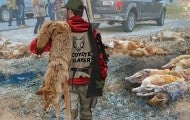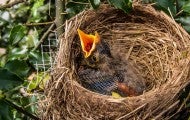WASHINGTON - The Humane Society of the United States released today the results of a disturbing undercover investigation into two wildlife killing contests in Frederick County and in Waldorf, Maryland. Investigators documented the judging portions of the events, with participants lining up rows of...
Today, veterinarians and 18 organizations, led by the Humane Society of the United States, submitted a petition to the Illinois Department of Natural Resources requesting that the agency initiate rulemaking to prohibit cruel, unnecessary wildlife killing contests in the state. At least 20 killing...
Somewhere toward the end of the last ice age, we formed an alliance with wolves: Maybe the ancestors of dogs got food scraps while our own ancestors gained protection from predators and other humans. These social species eventually collaborated on a vast scale, possibly even hunting woolly mammoths...
An eco-friendly getaway known as the Hideaway Ranch and Refuge in north Texas became one of the founding members of the Humane Stewardship Alliance. The Hideaway focuses on giving guests a relaxing stay in a natural setting, where they can unplug and unwind with such pastimes as hiking the trails...
Longtime Trust friend Fred Ziegler became the first founding member of the Humane Stewardship Alliance, pledging to follow humane stewardship principles in managing his nearly 2900 acres in Tennessee. With three streams and 1.5 miles of frontage along one of North America’s most biologically rich...
Fur factory farms and trappers kill millions of animals each year using brutal methods just for their fur. With your help, the Humane Society of the United States is fighting back—and winning—with brands, cities and countries moving away from fur. But to make progress, we need you. There are five...










